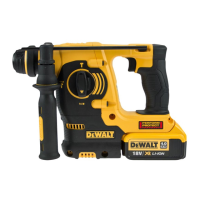WARNING: To reduce the risk of serious personal injury, ALWAYS
hold securely in anticipation of a suddenreaction.
Proper hand position requires one hand on the side handle, with the
other hand on the mainhandle.
FIG. 10
Drilling (Fig. 4)
WARNING: To reduce the risk of personal injury, ALWAYS operate
the tool with the side handle properly installed. Failure to do so may
result in the side handle slipping during tool operation and subsequent
loss of control. Hold tool with both hands to maximizecontrol.
NOTICE: If drilling thin material, use a wood “back-up” block to
prevent damage to thematerial.
1. Turn the mode selector (D) to the drill symbol (J).
2. Use sharp drill bits only. For WOOD, use twist bits, spade bits,
power auger bits or hole saws. For METAL, use high-speed steel
twist drill bits or hole saws. Use a cutting lubricant when drilling
metals. The exceptions are cast iron and brass which should be
drilled dry. For MASONRY, such as brick, cement, cinder block,
etc., use carbide-tipped bits rated for percussiondrilling.
3. Always apply pressure in a straight line with the bit. Use enough
pressure to keep drill biting, but do not push hard enough to stall
the motor or deflect thebit.
4. Hold tool firmly with both hands to control the twisting action of
the drill. If model is not equipped with side handle, grip drill with one
hand on the handle and one hand on the batterypack.
WARNING: Drill may stall if overloaded causing a sudden twist.
Always expect the stall. Grip the drill firmly to control the twisting
action and avoidinjury.
5. IF DRILL STALLS, it is usually because it is being overloaded
or improperly used. RELEASE TRIGGER IMMEDIATELY,
remove drill bit from work, and determine cause of stalling. DO
NOT DEPRESS TRIGGER ON AND OFF IN AN ATTEMPT
TO START A STALLED DRILL — THIS CAN DAMAGE
THEDRILL.
6. To minimize stalling or breaking through the material, reduce
pressure on drill and ease the bit through the last fractional part of
thehole.
7
. Keep the motor running when pulling the bit back out of a drilled
hole. This will help preventjamming.
8
. With variable speed drills there is no need to center punch
the point to be drilled. Use a slow speed to start the hole and
accelerate by squeezing the trigger harder when the hole is deep
enough to drill without the bit skippingout.
DRILLING IN METAL
An SDS Plus to round shank adaptor chuck is required. Ensure that
tool is in drill-only mode. Start drilling with slow speed and increase to
full power while applying firm pressure on the tool. A smooth even flow
of metal chips indicates the proper drilling rate. Use a cutting lubricant
when drilling metals. The exceptions are cast iron and brass which
should be drilleddry.

